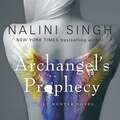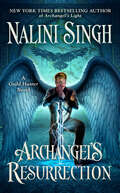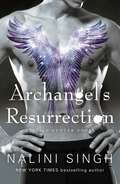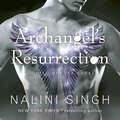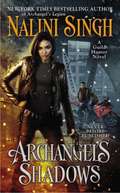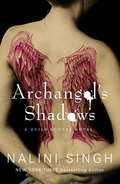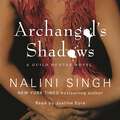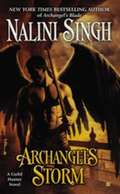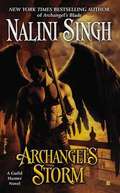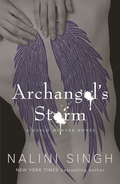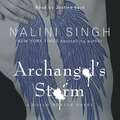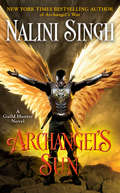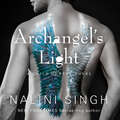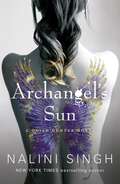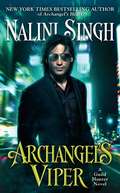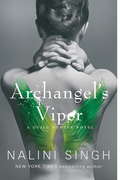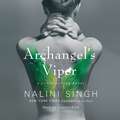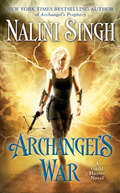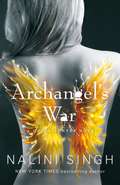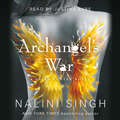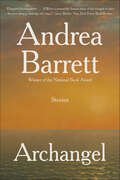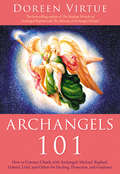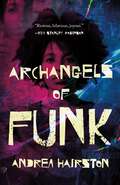- Table View
- List View
Archangel's Prophecy: Guild Hunter Book 11 (The Guild Hunter Series)
by Nalini SinghReturn to New York Times bestselling author Nalini Singh's darkly passionate Guild Hunter world, where human-turned-angel Elena Deveraux, consort to Archangel Raphael, is thrust centre stage into an eons-old prophecy . . . Midnight and dawn, Elena's wings are unique among angelkind . . . and now they're failing. The first mortal to be turned into an immortal in angelic memory, she's regressing. Becoming more and more human. Easier to hurt. Easier to kill. Elena and Raphael must unearth the reason for the regression before it's too late, and Elena falls out of the sky. Yet even as they fight a furious battle for Elena's very survival, violent forces are gathering in New York and across the world.In China, the Archangel Favashi is showing the first signs of madness. In New York, a mysterious sinkhole filled with lava swallows a man whole. In Africa, torrential monsoon rains flood rolling deserts. And in Elena's mind whispers a haunting voice that isn't her own. This time, survival may not be possible . . . not even for the consort of an archangel.Praise for the GUILD HUNTER novels:'Complex worldbuilding and the perfect balance of horror, heroism, passion, honour, and, always, always, a message of redemptive love' Kirkus Reviews 'Pure reading pleasure' Romantic Times(p) Tantor Media 2018
Archangel's Resurrection (A Guild Hunter Novel #15)
by Nalini SinghNew York Times bestselling author Nalini Singh takes us into the dangerous, haunting world of archangels . . . and a love that is legend. For thousands of years, the passion between Alexander, Archangel of Persia, and Zanaya, Queen of the Nile, burned furious and bright, seemingly without end. But to be an archangel is to be bound to power violent and demanding. Driven by its primal energy, Alexander and Zanaya fought as fiercely as they loved, locked in an endless cycle of devotion and heartbreak. It is only Zanaya&’s decision to Sleep that ends their love story. Eons later, the Cascade of Death wakens them both. The passion between them a flame that yet burns, Alexander and Zanaya stand together in one last battle against the ultimate darkness. But even a warrior archangel cannot win every war. Alexander&’s scream shatters the world as Zanaya falls, broken and silent . . . only to rise again in a miracle that may be a devastating curse. For is it truly the Queen of the Nile who has been resurrected? Only one thing is clear: This is the last beat of their passionate, angry dance. The final song for Alexander and his Zani . . .
Archangel's Resurrection (The Guild Hunter Series)
by Nalini SinghNew York Times bestselling author Nalini Singh takes us into the dangerous, haunting world of archangels . . . and a love that is legend.For thousands of years, the passion between Alexander, Archangel of Persia, and Zanaya, Queen of the Nile, burned furious and bright, seemingly without end. But to be an archangel is to be bound to power violent and demanding. Driven by its primal energy, Alexander and Zanaya fought as fiercely as they loved, locked in an endless cycle of devotion and heartbreak. It is only Zanaya's decision to Sleep that ends their love story.Eons later, the Cascade of Death wakens them both. The passion between them a flame that yet burns, Alexander and Zanaya stand together in one last battle against the ultimate darkness. But even a warrior archangel cannot win every war. Alexander's scream shatters the world as Zanaya falls, broken and silent . . . only to rise again in a miracle that may be a devastating curse. For is it truly the Queen of the Nile who has been resurrected? Only one thing is clear: This is the last beat of their passionate, angry dance. The final song for Alexander and his Zani . . .
Archangel's Resurrection (The Guild Hunter Series)
by Nalini SinghNew York Times bestselling author Nalini Singh takes us into the dangerous, haunting world of archangels . . . and a love that is legend.For thousands of years, the passion between Alexander, Archangel of Persia, and Zanaya, Queen of the Nile, burned furious and bright, seemingly without end. But to be an archangel is to be bound to power violent and demanding. Driven by its primal energy, Alexander and Zanaya fought as fiercely as they loved, locked in an endless cycle of devotion and heartbreak. It is only Zanaya's decision to Sleep that ends their love story.Eons later, the Cascade of Death wakens them both. The passion between them a flame that yet burns, Alexander and Zanaya stand together in one last battle against the ultimate darkness. But even a warrior archangel cannot win every war. Alexander's scream shatters the world as Zanaya falls, broken and silent . . . only to rise again in a miracle that may be a devastating curse. For is it truly the Queen of the Nile who has been resurrected? Only one thing is clear: This is the last beat of their passionate, angry dance. The final song for Alexander and his Zani . . .
Archangel's Shadows
by Nalini SinghNEVER BEFORE PUBLISHED AN ALL-NEW GUILD HUNTER NOVEL Return to New York Times bestselling author Nalini Singh's sensual and painfully beautiful Guild Hunter world in her new novel of sacrifice, loyalty, and the choices of love that can shatter the heart. In the wake of a brutal war, the archangel Raphael and his hunter consort, Elena, are dealing with the treacherously shifting tides of archangelic politics and the people of a battered but not broken city. The last thing their city needs is more death, especially a death that bears the eerie signature of an insane enemy archangel who cannot--should not--be walking the streets. This hunt must be undertaken with stealth and without alerting their people. It must be handled by those who can become shadows themselves... Ash is a gifted tracker and a woman cursed with the ability to sense the secrets of anyone she touches. But there's one man she knows all too well without a single instant of skin contact: Janvier, the dangerously sexy Cajun vampire who has fascinated and infuriated her for years. Now, as they track down a merciless killer, their cat-and-mouse game of flirtation and provocation has turned into a profound one of the heart. And this time, it is Ash's secret, dark and terrible, that threatens to destroy them both.
Archangel's Shadows: Book 7 (The Guild Hunter Series)
by Nalini SinghReturn to the sensual and painfully beautiful Guild Hunter world, with a new novel about sacrifice, loyalty and the choices of love that can shatter the heart.In the wake of a brutal war, the archangel Raphael and his hunter consort Elena are dealing with the treacherously shifting tides of archangelic politics and the people of a battered but not broken city. The last thing their city needs is more death, especially not a death that bears the eerie signature of an insane enemy archangel who cannot - should not - be walking the streets. This hunt must be undertaken with stealth and without alerting their people. It must be handled by those who can become shadows themselves ...Ash is a gifted tracker and a woman cursed with the ability to sense the secrets of anyone she touches. But there's one man she knows all too well without a single instant of skin contact: Janvier, the dangerously sexy Cajun vampire who has fascinated and infuriated her for years. Now, as they track down a merciless killer, their cat-and-mouse game of flirtation and provocation has turned into a profound one of the heart. And this time, it is Ash's secret, dark and terrible, that threatens to destroy them both.Nalini Singh, the NEW YORK TIMES bestselling 'alpha author of paranormal romance' (BOOKLIST), returns to her stunning world, as it braces itself for destruction.
Archangel's Shadows: Book 7 (The Guild Hunter Series)
by Nalini SinghReturn to the sensual and painfully beautiful Guild Hunter world, with a new novel about sacrifice, loyalty and the choices of love that can shatter the heart.In the wake of a brutal war, the archangel Raphael and his hunter consort Elena are dealing with the treacherously shifting tides of archangelic politics and the people of a battered but not broken city. The last thing their city needs is more death, especially not a death that bears the eerie signature of an insane enemy archangel who cannot - should not - be walking the streets. This hunt must be undertaken with stealth and without alerting their people. It must be handled by those who can become shadows themselves ...Ash is a gifted tracker and a woman cursed with the ability to sense the secrets of anyone she touches. But there's one man she knows all too well without a single instant of skin contact: Janvier, the dangerously sexy Cajun vampire who has fascinated and infuriated her for years. Now, as they track down a merciless killer, their cat-and-mouse game of flirtation and provocation has turned into a profound one of the heart. And this time, it is Ash's secret, dark and terrible, that threatens to destroy them both.Nalini Singh, the NEW YORK TIMES bestselling 'alpha author of paranormal romance' (BOOKLIST), returns to her stunning world, as it braces itself for destruction.Read by Justine Eyre(p) 2014 Tantor Media Inc
Archangel's Storm
by Nalini SinghEnter New York Times bestselling author Nalini Singh's darkly beautiful world of archangels and immortal power, as a pact is sealed between two souls bound by blood, stirred by desire, and driven by vengeance... With wings of midnight and an affinity for shadows, Jason courts darkness. But now, with the Archangel Neha's consort lying murdered in the jewel-studded palace that was his prison and her rage threatening cataclysmic devastation, Jason steps into the light, knowing he must unearth the murderer before it is too late. Earning Neha's trust comes at a price--Jason must tie himself to her bloodline through the Princess Mahiya, a woman with secrets so dangerous, she trusts no one. Least of all an enemy spymaster. With only their relentless hunt for a violent, intelligent killer to unite them, Jason and Mahiya embark on a quest that leads to a centuries-old nightmare... and to the dark storm of an unexpected passion that threatens to drench them both in blood.
Archangel's Storm
by Nalini SinghEnter New York Times bestselling author Nalini Singh's darkly beautiful world of archangels and immortal power, as a pact is sealed between two souls bound by blood, stirred by desire, and driven by vengeance... With wings of midnight and an affinity for shadows, Jason courts darkness. But now, with the Archangel Neha's consort lying murdered in the jewel-studded palace that was his prison and her rage threatening cataclysmic devastation, Jason steps into the light, knowing he must unearth the murderer before it is too late. Earning Neha's trust comes at a price--Jason must tie himself to her bloodline through the Princess Mahiya, a woman with secrets so dangerous, she trusts no one. Least of all an enemy spymaster. With only their relentless hunt for a violent, intelligent killer to unite them, Jason and Mahiya embark on a quest that leads to a centuries-old nightmare... and to the dark storm of an unexpected passion that threatens to drench them both in blood.
Archangel's Storm (Guild Hunter, Book #5)
by Nalini SinghEnter New York Times bestselling author Nalini Singh's darkly beautiful world of archangels and immortal power, as a pact is sealed between two souls bound by blood, stirred by desire, and driven by vengeance... With wings of midnight and an affinity for shadows, Jason courts darkness. But now, with the Archangel Neha's consort lying murdered in the jewel-studded palace that was his prison and her rage threatening cataclysmic devastation, Jason steps into the light, knowing he must unearth the murderer before it is too late. Earning Neha's trust comes at a price--Jason must tie himself to her bloodline through the Princess Mahiya, a woman with secrets so dangerous, she trusts no one. Least of all an enemy spymaster. With only their relentless hunt for a violent, intelligent killer to unite them, Jason and Mahiya embark on a quest that leads to a centuries-old nightmare... and to the dark storm of an unexpected passion that threatens to drench them both in blood.
Archangel's Storm: Book 5 (The Guild Hunter Series)
by Nalini SinghRich, dark, sumptuous and evocative ... bestselling author Nalini Singh is back with a stunning new tale in her deadly, beautiful world where angels rule and vampires serve.With wings of midnight and an affinity for shadows, Jason courts darkness. But now, with the Archangel Neha's consort lying murdered and her rage threatening cataclysmic devastation, Jason steps into the light, knowing he must unearth the murderer before it is too late.Earning Neha's trust comes at a price - Jason must tie himself to her bloodline through the Princess Mahiya, a woman with secrets so dangerous, she trusts no one. Least of all an enemy spymaster.With only their relentless hunt for a violent, intelligent killer to unite them, Jason and Mahiya embark on a quest that leads to a centuries-old nightmare ... and to the dark storm of an unexpected passion that threatens to drench them both in blood.
Archangel's Storm: Book 5 (The Guild Hunter Series)
by Nalini SinghRich, dark, sumptuous and evocative ... bestselling author Nalini Singh is back with a stunning new tale in her deadly, beautiful world where angels rule and vampires serve.With wings of midnight and an affinity for shadows, Jason courts darkness. But now, with the Archangel Neha's consort lying murdered and her rage threatening cataclysmic devastation, Jason steps into the light, knowing he must unearth the murderer before it is too late.Earning Neha's trust comes at a price - Jason must tie himself to her bloodline through the Princess Mahiya, a woman with secrets so dangerous, she trusts no one. Least of all an enemy spymaster.With only their relentless hunt for a violent, intelligent killer to unite them, Jason and Mahiya embark on a quest that leads to a centuries-old nightmare ... and to the dark storm of an unexpected passion that threatens to drench them both in blood.Read by Justine Eyre(p) 2012 Tantor Media Inc
Archangel's Sun (A Guild Hunter Novel #13)
by Nalini SinghA horrifying secret rises in the aftermath of an archangelic war in New York Times bestselling author Nalini Singh&’s deadly and beautiful Guild Hunter world. . . .The Archangel of Death and the Archangel of Disease may be gone but their legacy of evil lives on—especially in Africa, where the shambling, rotting creatures called the reborn have gained a glimmer of vicious intelligence.It is up to Titus, archangel of this vast continent, to stop the reborn from spreading across the world. Titus can&’t do it alone, but of the surviving powerful angels and archangels, large numbers are wounded, while the rest are fighting a surge of murderous vampires.There is no one left . . . but the Hummingbird. Old, powerful, her mind long a broken kaleidoscope. Now, she must stand at Titus&’s side against a tide of death upon a discovery more chilling than any other. For the Archangel of Disease has left them one last terrible gift . . . .
Archangel's Sun: Guild Hunter Book 13 (The Guild Hunter Series)
by Nalini SinghA horrifying secret rises in the aftermath of an archangelic war in New York Times bestselling author Nalini Singh's deadly and beautiful Guild Hunter world...The Archangel of Death and the Archangel of Disease may be gone but their legacy of evil lives on - especially in Africa, where the shambling, rotting creatures called the reborn have gained a glimmer of vicious intelligence.It is up to Titus, archangel of this vast continent, to stop the reborn from spreading across the world. Titus can't do it alone, but of the surviving powerful angels and archangels, large numbers are wounded, while the rest are fighting a surge of murderous vampires.There is no one left . . . but the Hummingbird. Old, powerful, her mind long a broken kaleidoscope. Now she must stand at Titus's side against a tide of death, upon a discovery more chilling than any other. For the Archangel of Disease has left them one last terrible gift . . .'Singh's worldbuilding and imagination never disappoint' Kirkus 'Spellbinding paranormal romance' Publishers Weekly
Archangel's Sun: Guild Hunter Book 13 (The Guild Hunter Series)
by Nalini SinghA horrifying secret rises in the aftermath of an archangelic war in New York Times bestselling author Nalini Singh's deadly and beautiful Guild Hunter world...The Archangel of Death and the Archangel of Disease may be gone but their legacy of evil lives on - especially in Africa, where the shambling, rotting creatures called the reborn have gained a glimmer of vicious intelligence.It is up to Titus, archangel of this vast continent, to stop the reborn from spreading across the world. Titus can't do it alone, but of the surviving powerful angels and archangels, large numbers are wounded, while the rest are fighting a surge of murderous vampires.There is no one left . . . but the Hummingbird. Old, powerful, her mind long a broken kaleidoscope. Now she must stand at Titus's side against a tide of death, upon a discovery more chilling than any other. For the Archangel of Disease has left them one last terrible gift . . .'Singh's worldbuilding and imagination never disappoint' Kirkus 'Spellbinding paranormal romance' Publishers Weekly
Archangel's Viper
by Nalini SinghEnter New York Times bestselling author Nalini Singh’s breathtakingly passionate Guild Hunter world with the story of a woman who isn’t a vampire or an angel…or human… Once a broken girl known as Sorrow, Holly Chang now prowls the shadowy gray underground of the city for the angels. But it’s not her winged allies who make her a wanted woman—it’s the unknown power coursing through her veins. Brutalized by an insane archangel, she was left with the bloodlust of a vampire, the ability to mesmerize her prey, and a poisonous bite. Now, someone has put a bounty on her head… Venom is one of the Seven, Archangel Raphael’s private guard, and he’s as infuriating as he is seductive. A centuries-old vampire, his fangs dispense a poison deadlier than Holly’s. But even if Venom can protect Holly from those hunting her, he might not be able to save himself—because the strange, violent power inside Holly is awakening… No one is safe.
Archangel's Viper: Book 10 (The Guild Hunter Series)
by Nalini SinghEnter New York Times bestselling author Nalini Singh's breathtakingly passionate Guild Hunter world with the story of a woman who isn't a vampire or an angel . . . or human . . . Once a broken girl known as Sorrow, Holly Chang now prowls the shadowy grey underground of the city for the angels. But it's not her winged allies who make her a wanted woman - it's the unknown power coursing through her veins. Brutalised by an insane archangel, she was left with the bloodlust of a vampire, the ability to mesmerise her prey, and a poisonous bite. Now, someone has put a bounty on her head . . . Venom is one of the Seven, Archangel Raphael's private guard, and he's as infuriating as he is seductive. A centuries-old vampire, his fangs dispense a poison deadlier than Holly's. But even if Venom can protect Holly from those hunting her, he might not be able to save himself - because the strange, violent power inside Holly is awakening . . . No one is safe.
Archangel's Viper: Book 10 (The Guild Hunter Series)
by Nalini SinghEnter New York Times bestselling author Nalini Singh's breathtakingly passionate Guild Hunter world with the story of a woman who isn't a vampire or an angel . . . or human . . . Once a broken girl known as Sorrow, Holly Chang now prowls the shadowy grey underground of the city for the angels. But it's not her winged allies who make her a wanted woman - it's the unknown power coursing through her veins. Brutalised by an insane archangel, she was left with the bloodlust of a vampire, the ability to mesmerise her prey, and a poisonous bite. Now, someone has put a bounty on her head . . . Venom is one of the Seven, Archangel Raphael's private guard, and he's as infuriating as he is seductive. A centuries-old vampire, his fangs dispense a poison deadlier than Holly's. But even if Venom can protect Holly from those hunting her, he might not be able to save himself - because the strange, violent power inside Holly is awakening . . . No one is safe.Read by Justine Eyre(p) 2017 Tantor Media
Archangel's War (A Guild Hunter Novel #12)
by Nalini SinghReturn to New York Times bestselling author Nalini Singh’s darkly passionate Guild Hunter world, where human-turned-angel Elena Deveraux, consort to Archangel Raphael, faces a new challenge that threatens the balance of the world. <P><P>Wings of silver. Wings of blue. Mortal heart. Broken dreams. Shatter. Shatter. Shatter. A sundering. A grave. I see the end. I see. . . . <P><P>The world is in chaos as the power surge of the Cascade rises to a devastating crescendo. In furiously resisting its attempts to turn Elena into a vessel for Raphael’s power, Elena and her archangel are irrevocably changed. . .far beyond the prophecy of a cursed Ancient. <P><P>At the same time, violent and eerie events around the world threaten to wipe out entire populations. And in the Archangel Lijuan’s former territory, an unnatural fog weaves through the land, leaving only a bone-chilling silence in its wake. Soon it becomes clear that even the archangels are not immune to this deadly evil. This time, even the combined power of the Cadre may not be enough. . . . <P><P>This war could end them all. <P><P><b>A New York Times Bestseller</b>
Archangel's War: Guild Hunter Book 12 (The Guild Hunter Series)
by Nalini SinghAn instant New York Times bestseller! Return to Nalini Singh's darkly passionate Guild Hunter world, where human-turned-angel Elena Deveraux, consort to Archangel Raphael, faces a new challenge that threatens the balance of the world.Wings of silver. Wings of blue. Mortal heart. Broken dreams. Shatter. Shatter. Shatter. A sundering. A grave. I see the end. I see . . .The world is in chaos as the power surge of the Cascade rises to a devastating crescendo. In furiously resisting its attempts to turn Elena into a vessel for Raphael's power, Elena and her archangel are irrevocably changed . . . far beyond the prophecy of a cursed Ancient.At the same time, violent and eerie events around the world threaten to wipe out entire populations. And in the Archangel Lijuan's former territory, an unnatural fog weaves through the land, leaving only a bone-chilling silence in its wake. Soon it becomes clear that even the archangels are not immune to this deadly evil. This time, even the combined power of the Cadre may not be enough . . .This war could end them all.
Archangel's War: Guild Hunter Book 12 (The Guild Hunter Series)
by Nalini SinghWings of silver. Wings of blue. Mortal heart. Broken dreams. Shatter. Shatter. Shatter. A sundering. A grave. I see the end. I see . . .The world is in chaos as the power surge of the Cascade rises to a devastating crescendo. In furiously resisting its attempts to turn Elena into a vessel for Raphael's power, Elena and her archangel are irrevocably changed . . . far beyond the prophecy of a cursed Ancient.At the same time, violent and eerie events around the world threaten to wipe out entire populations. And in the Archangel Lijuan's former territory, an unnatural fog weaves through the land, leaving only a bone-chilling silence in its wake. Soon it becomes clear that even the archangels are not immune to this deadly evil. This time, even the combined power of the Cadre may not be enough . . .This war could end them all.
Archangel: Stories
by Andrea Barrett"Elegantly contemplative.…[O]ffers a powerfully human sense of the struggle it takes for new ideas to dislodge old ones." —Janet Maslin, New York Times Book Review Dramas both personal and cosmic unfold around five pivotal moments in the history of knowledge in this collection from the "genius enchantress" (Karen Russell) author of Ship Fever, winner of the National Book Award.A young boy comes of age amid an explosion of homespun investigations. A widowed science writer tries to reconcile the influence of emotion on scientific theory. A famous biologist finds himself outpaced by his students, even as he seeks to teach them. As the characters in this "elegant, thought-provoking" (Connie Ogle, Miami Herald) collection witness the world transform around them through groundbreaking discoveries—the flight of an early aeroplane, Darwin’s theory of evolution, developments in genetics and X-ray technology—they grapple with the thrill and loss that accompanies scientific progress, and the personal passions and impersonal politics that shape all human knowledge. Throughout these deftly plotted stories, Andrea Barrett weaves subtle connections among the tales within this collection and characters in her earlier works.
Archangels & Ascended Masters: A Guide To Working And Healing With Divinities And Deities
by Doreen VirtueArchangels and Ascended Masters is a thoroughly researched book in a lively encyclopedia format, listing 77 divinities from Greek, Roman, Egyptian, Asian, Babylonian, Tibetan, Buddhist, Celtic, Theosophical, New Age, Catholic, Cabalistic, Jewish, and Christian roots. Doreen carefully studied and wrote about the history of each deity, what role they serve today, how they can help us with specific life problems, and how to call upon each one. <p><p>Doreen spent time in communication with each divinity to ensure that the being was reachable, and to discover the essence of his or her personality and current dealings with the world—and within these pages, she includes a channeled message or impression from each of the ascended masters and archangels. Many of her channelings were conducted at power points throughout the world, such as Stonehenge in England; the Irish coast; Kona, Hawaii; and the New Zealand rain forest. <p><p>A comprehensive chart lists a number of life situations, such as Addictions, Finding a Soulmate, Emergency Money, Healing Physical Illness, and various personal and family concerns. Beneath each topic is the list of whom to call upon when dealing with that particular challenge. Doreen also includes prayers to call upon multiple divinities for specific issues such as "increased clairvoyance" and "resolving conflict."
Archangels 101: How To Connect Closely With Archangels Michael, Raphael, Uriel, Gabriel And Others For Healing, Protection, And Guidance
by Doreen VirtueLegions of loving and trustworthy archangels watch over us, and you can develop an even closer relationship with them by learning their names and specialties. In this uplifting nondenominational book, Doreen Virtue guides you in connecting with her 15 favorite archangels; and you’ll read true stories from people who received protection, miraculous healings, and amazing guidance from these beloved heavenly beings. Archangels want to help each and every one of you live healthier and happier lives. As unlimited beings, archangels can assist everyone simultaneously, and this fascinating book will teach you which archangels to call upon for various situations. Whether you’re new to working with angels, or someone who has believed in angels all your life, you’ll want to refer to Archangels 101 again and again.
Archangels of Funk
by Andrea HairstonRun from your past. Hide from your future. Protect your present.The Water Wars have scrambled the world. Flood refugees are on the run. Disrupters and the nostalgia militia roam the roads wreaking havoc. Invisible Darknet Lords troll the internet, solidifying their power, while Cinnamon, her three Circus-Bots, and two dogs work with a community of farmers, Motor Fairies, and Wheel-Wizards to provide housing, health care and education for flood refugees.As Cinnamon confronts threats from the Darknet Lords and the nostalgia militia, she must determine how best to honor her elders and her history while building a future for herself and her charges.It’s not going to be easy.Praise for Archangels of Funk:“Andrea Hairston creates original, layered, complex worlds that are a treat to explore, but what I love most is the people she creates for them. Archangels of Funk is brimming with characters who face adversity with love, hope, art, stories, history, and their bonds with each other. It's a celebration of radiant creativity as a bulwark against despair.”―Martha Wells, author of the Murderbot DiariesAt the Publisher's request, this title is being sold without Digital Rights Management Software (DRM) applied.
